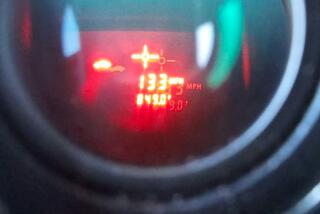Careful where you point it
- Share via
Toronto — The cop, a full-metal-jacketed member of the Ontario Provincial Police, walked up to the car, pushed his cap back and said, “New toy?”
Well, yes and no, Officer Neckfat. The Carrera GT, Porsche’s half-million-dollar sports car, a 605-horsepower linear-mass accelerator capable of more than 200 mph, is certainly new. The car is just now going into full production in Leipzig, Germany -- hand assembled at a rate of two per day -- and so far only about 50 have been delivered to North American customers, mostly juice-intensive celebs like Jerry Seinfeld and Tim Allen.
Toy? Oh, yeah. The car is the quintessence of uselessness. The car is perfect agony to drive in close-quarter traffic thanks to its stall-happy ceramic clutch. My wallet has more trunk space than the nose cone of this mid-engine monster. In terms of appropriateness, driving the newest, greatest Porsche hyper-car on the street is like deer hunting with ICBMs.
On the track, however, the Carrera GT sheds its sense of overgrown absurdity and becomes what it is: a sumptuously upholstered race car, a carbon-fiber lightning bolt hurled from Zuffenhausen at History itself.
There is nothing false, shallow or toy-like in the way the Carrera GT drives. This car is no gimmick, no vainglorious attempt to keep up with the Enzos. It is serious. Adult-strength. For mature audiences only. Double-black-diamond with an avalanche advisory. If you are not entirely respectful of the car’s power, it will hurt you.
This is a good thing.
At a time when, as sports car purists see it, the company’s cars grow less and less pure, with their multiple layers of traction, stability and brake controls, adaptive suspensions, speed-sensitive steering and cozening comforts like navigation systems and automatic transmissions; at a time when Porsche’s bestselling vehicle is, in fact, a truck (the Cayenne SUV); at a time when there is talk of Porsche building a four-door saloon like the Maserati Quattroporte, the final apostasy to the Porsche faithful, the Carrera GT redeems the company’s reputation as the maker of great sports cars for accomplished drivers.
The Carrera GT is uncompromised and uncompromising. The first impression one gets behind the wheel is one of off-the-scale, black-hole density, a gravitas that feels rooted in the Earth’s iron core. This is the sort of vibration-free platform they build giant telescopes on.
Instead of a paddle-shifted, clutchless gearbox, like those in the Ferrari Enzo or Lamborghini Murcielago, the Carrera GT has a conventional six-speed manual transmission with steel rod linkages between its wood-knob shifter and the transaxle. This is velocity, old school. Unlike the Ford GT, the Carrera GT uses a pushrod suspension. This space-saving design, common in race cars, uses linkages connected to a rocker-arm pivot to redirect vertical wheel movements to laterally mounted spring-and-damper units. Three-way adjustable anti-roll bars spider across the front and rear of the chassis.
Rather than sacrifice a scintilla of handling sharpness to comfort, the double-wishbone suspension pieces are connected to the carbon-fiber chassis (the tub) with solid-steel joints, without any elastic bushings that might otherwise soften the ride. The car’s ride quality is nonetheless unusually good, while the handling is mercilessly sensitive and accurate. There is zero free play in the power-assisted steering. The Carrera GT is the kind of car you drive with your fingertips so that you avoid putting the slightest pressure on the wheel as you brace yourself.
It goes where you point it, so be careful where you point it.
The reactor core is an all-alloy, naturally aspirated V10 (no superchargers or turbochargers) displacing 5.7 liters and breathing through 4-valve-per cylinder heads with variable-intake timing. The engine is a dry-sump unit (there is no oil pan beneath the engine), meaning that the engine’s weight can be situated lower in the car, for a lower center of gravity. The engine oil reservoir is cast inside the alloy transaxle unit. To place the engine’s weight (472 pounds) lower still, the Carrera GT uses a tiny ceramic clutch assembly, a mere 6.5 inches in diameter. The distance from the crank center to the bottom of the car is only 3.9 inches.
What does all that mean? For one thing, it means that the car has enormous dynamic stability and virtually no body roll. The Michelin Pilot Sport 2s wrapped around ultra-light cast magnesium wheels might as well be made by the Elmer’s glue company. And when the car does begin to slide, you can just hold it out on the feathery edges of adhesion because the car is so effortlessly neutral and reactive. The hardest thing about the Carrera GT is to trust that this big car -- bigger than a Corvette -- will stay planted at cornering loads over 1 g. But it does.
One of the unique features of the Carrera GT is the powertrain frame that wraps around the engine and transaxle, a carbon-fiber cat’s cradle bolted to the tub firewall. Woven of iridescent fibers and infused with glassy resins, it’s a Faberge egg of car technology. Every place you look on this car harbors some glorious bit of engineering detailing. The hub-wrench fitting used to take off the center-lock wheel nuts is a gorgeous piece of precision milling autographed by the craftsman. This is one cool car.
It is also rather sporty. It will accelerate from 0-60 mph in 3.5 seconds, according to Car and Driver, and cover the quarter-mile in 11.2 seconds, with a trap speed of 132 mph. That last number is telling: This car doesn’t find its prodigious stride until it gets over 100 mph. From 0 to 100 mph takes a mere 6.8 seconds.
At speeds above 75 mph, the car deploys its rear spoiler to help create road-holding down force. At 186 mph the car is subjected to 880 pounds of down force, most of that generated from the ground-effects underbody and spoiler, but even the suspension arms are shaped like inverted wings to extract precious pounds of down force.
During my short stint in the car at Canada’s Mosport racetrack, the Carrera GT didn’t strike me as harrowingly fast. For one thing, you can’t do anything sudden or violent in this car. In slow-speed corners, you can breathe off the throttle slightly to generate some extra rotation and then squeeze the power. But you can’t toss it or punch it. And so the car has this serene inevitability to it, and the laps just surrender to it.
The Carrera GT also stops handily too, thanks to its four enormous, cross-drilled carbon-ceramic disc brakes. The car’s excellent anti-lock system allows you to stand on the brakes as you approach the corner. The car feels like it’s hit some sort of braking-zone force field.
I wish that I could report some heroic law-scoffing in the Carrera GT, a speeding ticket worthy of campfire tales in future years. But no. I got pulled over for 120 in an 80. That’s kilometers per hour. I’ll do the math for you: it’s about 74 mph in a 50 mph zone.
I explained that, considering the car I was driving, I had shown inhuman restraint. He wasn’t impressed and kept on writing.
*
Automotive critic Dan Neil can be reached at dan.neil@latimes.com
*
(BEGIN TEXT OF INFOBOX)
Porsche Carrera GT
Wheelbase: 107.5 inches
Length: 181.6 inches
Curb weight: 3,146 pounds
Powertrain: Naturally aspirated 5.7-liter DOHC V10, six-speed manual transmission, rear transaxle, rear-wheel drive with limited slip differential
Horsepower: 605 hp at 8,000 rpm
Torque: 435 pound-feet at 5,750 rpm
Acceleration: 0 to 60 mph in 3.5 seconds
Price, as tested: $448,400
Final thought: Dangerous liaison






